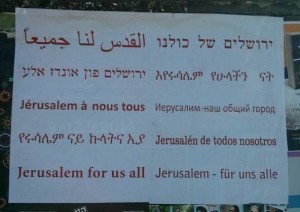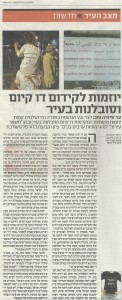Activists Wage Vigilante Efforts against Racism in Jerusalem – Haaretz article
This summer, Kikar Zion (Zion Square) in Jerusalem became a hot spot of xenophobia. It was not the first time for the Square, but this new wave began after the kidnapping and murder of three Jewish boys in June 2014. Nir Hasson reported in Haaretz on July 1, 2014:
Since the discovery of the three Israeli teens’ bodies on Monday, tensions have been rising between Jews and Arabs in Jerusalem with several assaults reported overnight. On Monday evening a spontaneous vigil was held in Zion Square, where people lit candles, prayed and sang. Yet on the sidelines of the vigil groups, young people gathered and began marching through the center of town yelling “Death to terrorists” and “Death to Arabs.” Most of these groups dispersed before any violent incidents occurred, mainly because many Arab workers were away for Ramadan. However, several assaults were reported overnight.
Interestingly, as documented in Hasson’s quote above, there were others, mostly students, who came to the exactly same Square to mourn and spread an alternative option for tolerance. These activists continued to come to the Square in the following months. In mid-August, we at the JICC decided to help this spontaneous group. While keeping it independent of any formal or organizational connection, we began to help in logistics, in convening meetings of the activists, in professional consultation. And yes, some of us became part of the group as activists… Hagai Agmon-Snir, the JICC director, wrote a Facebook post about his all-night experience at the Square.
Following the above Facebook post, Nir Hasson decided to come to Zion Square to write about it. He published the article in Haaretz on September 12, 2014 (Acrobat version) and the article was translated into English by Haaretz and was published in this version the following day (Acrobat version).
Here is the full text of the article:
Activists wage vigilante efforts against racism in Jerusalem
Faced with the rising prominence of Lehava, an anti-Arab organization, two groups try to promote dialogue and curb violence in the capital.
By Nir Hasson | Sep. 13, 2014 |
Every Thursday and Saturday night, Jerusalem’s Zion Square becomes a scene of confrontation. On those evenings, activists from Lehava – an organization whose name is a Hebrew acronym for “fighting assimilation in the Holy Land” – gather in the square, dressed in black shirts emblazoned with the words “Jewish honor guard,” to hand out fliers bearing slogans like “don’t let your daughters work with Arabs” and “don’t buy from stores that employ your enemies.”
After midnight, the black-shirted activists dismantle their unauthorized booth and begin to disperse, and police presence thins out. That’s when things turn violent: Youths harass passersby, attack taxi drivers and interrogate couples to determine whether they are Arabs or Jews.
Facing off against the racism, for the past two months, have been two different groups. One, which calls itself City Guard, is composed of veteran left-wing activists and sees its mission as protecting the victims. If their very presence doesn’t deter attacks, they will call the police and even physically interpose themselves between assailants and their prey. They start work around 1 A.M., when the Lehava activists begin to disperse and when people start spilling out of nightclubs, often drunk and ripe for violence.
The second group is more diverse, comprised of religious, secular and formerly religious students, mostly from Jerusalem but some from West Bank settlements. They see their job as trying to persuade the Lehava activists that racism is wrong, or at least to mitigate the violence.
Lehava activists have been instructed by the organization’s leaders not to get into debates with the students, but most ignore this order. The arguments often turn into cussing matches and even shoving spats. But occasionally, they manage to spark serious discussions about Judaism, nationalism, racism and human rights.
This summer’s war in Gaza and the rioting in East Jerusalem have been good for Lehava, turning it from a marginal group into a proud organization with hundreds of activists in many cities. Its Facebook pages may have been taken down, but it gets plenty of media coverage, which reached a peak three weeks ago when Morel Malka, a Jew who converted to Islam, married Mahmoud Mansour, an Arab.
Its opponents say Lehava is the wellspring from which violence against Arabs in Jerusalem flows.
Ofek Birnholtz, a doctoral student in physics, is one of the founders of the group of students that tries to reason with Lehava members. Last Thursday, he had a long and stormy discussion with one activist about Judaism’s attitude toward the stranger. “I won’t convince him,” Birnholtz admitted, “but maybe I’ll make him think a little more. The very fact that we’re here creates a dynamic of less violence and more dialogue. It’s a holding action.”
Hagai Agmon-Snir, director of the Jerusalem Intercultural Center and another member of the dialogue group, added, “When we talk with these teens, they insist they aren’t violent and aren’t coming from a place of racism or hating Arabs, that they just oppose assimilation. I’m not so naïve to think there’s no racism there, but this says it’s important to them to remain within the camp that says it’s not racist, and that’s a thread we can work with.”
Yovel Zim, a religious Jew from the settlement of Tekoa, said the Lehava activists “find it harder to deal with people like me. They immediately brand me as a leftist or say I’m not really religious because according to the Torah, all Arabs are enemies.”
But the one who annoys the Lehava members most is Yuval Ben-Ari, who insists on telling them about both his Arab roommate and his army reserve service. “I’m here because I returned from 35 days of reserve duty and heard that friends of mine had been beaten because they’re leftists,” he said.
One night, a Lehava activist tried to make him leave, shouting, “You’re nothing; you’re a wretch; you don’t care about anyone; you’re a disgusting egotist!” Soon Anat Gopstein, the wife of Lehava founder Benzion Gopstein, chimed in. “You don’t look to me like someone who does reserve duty and cares about the state,” she said. “You act like a sick person, a deviant.”
The harsh words aren’t unusual. Shoving ensued on the night in question, and the students say they are sometimes spat at. On one occasion a lit cigarette was thrown toward one of them. Nevertheless, they persist.
‘Authorities turn blind eye’
Some within the second group, the so-called City Guard, view the students’ efforts as wasted. Others even claim that their attempts at dialoge legitimize racism.
“It normalizes the situation,” says Eyal, a Jerusalemite and a co-founder the Guard. “You see the dynamic: There’s a booth that distributes racist flyers, and it’s surrounded by people who are standing around and talking like everything’s fine.
“There should be more physical resilience, awareness must be raised to make the authorities wake up,” he added.
Both groups agree that Israel’s authorities and mainstream society are turning a blind eye to racist activity.
“These days, shouting ‘death to Arabs’ in the middle of Jaffa Street is okay; nothing should be done about it,” Aviv Tatarsky says wryly.
“We shouldn’t be here,” adds Eyal. “We should be in East Jerusalem, shouting ‘occupation, occupation.’ The mainstream groups should be here – the youth organizations, city workers, and the police. But no one is here. Except for Reuven Rivlin, who spoke out, everyone is silent.”
According to Eyal, “Arabs are scared to walk around here … and the vast majority is willing to accept this.”
The municipality’s helplessness is evident as it disregards Lehava’s illegal booth, the leftist activists say. The dialogue group had asked the city to dismantle the stand early in the evening and was promised that action would be taken. Yet four hours later, no official had arrived on the scene.
The municipality, however, denied failing to enforce the law. A spokesman acknowledged that the booth was set up without a permit, but claimed the city had it dismantled immediately. The booth’s operators were informed that they must receive the city’s authorization to set up the stand, as well as for the content of the flyers it distributes. If they set up the stand again without a permit, it will be confiscated, according to the spokesman.
Both groups were founded on the evening that three Israeli teens who were murdered in the West Bank were laid to rest – hours before the murder of a Palestinian teen, Mohammed Abu Khdeir. On that day, a rightist demonstration turned into a series of violent acts targeting Arabs in Jerusalem’s center. Two days later, a leftist rally gathered in a Jerusalem plaza known as Cat Square to protest the violence. Some 1,000 activists arrived at the demonstration, organized by the Tag Meir organization. Once the speeches were over, the protesters quickly dispersed, to be replaced by Lehava activists.
“They started yelling ‘death to Arabs,'” recalls Birnholtz. “The [protesters] left and the city was once again forsaken, and we knew that we had another long night ahead of us.”



